by Margaret Sgarra, contemporary art curator
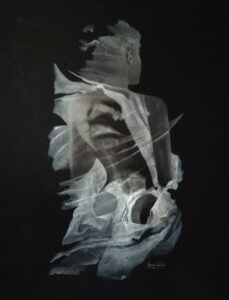
IroPeinto, stage name of Veronica Larotonda, is a visual artist who works using different pictorial languages, such as painting on water, the Ebrù technique and oil connected to metals. The focus of her work is centered on form, which becomes something incomprehensible and elusive, at times elusive. Furthermore, the relationship with dreams is fundamental, as it proves to be a field of investigation in correlation with the unconscious. She currently lives and works in Milan.
Your works focus on complex and elusive structures. What is your relationship with form?
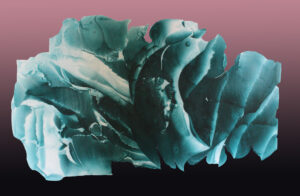
It is a reflective relationship. The shapes I paint represent human nature’s complexity and the desire to explore the boundaries between known reality and imagination. In this way they are able to give a visual form to concepts which are by their nature otherwise elusive, such as emotions, thoughts or dreams. Through shapes, I try to capture the essence of something that is not tangible, like the fluidity of existence and the beauty of ambiguity, as well as giving life to a visual language which speaks directly to the unconscious. In this case the form is an invitation to let go, to contemplate one’s relationship with the world, and find individual meanings in art that transcend conventional definitions.
References to the dream sphere and the unconscious are recurring within your research. What connects you to these themes and how do you develop them?
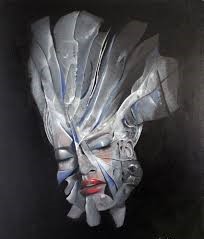
Connection is defined by how I consider the creative expression: it is first and foremost a form of relief, a safe haven from reality, and a means of self-exploration. In addition to a door to one’s inner world, I consider the dream component as a universal human experience, which allows to a profound communication between people. Therefore I think that trying to represent it in a conscious and meaningful way can create an empathetic bridge between the artist and the observer. Furthermore, painting the dream has the advantage of pushing me towards creative innovation, experimenting with shapes, colors and materials in new ways. For me, dream art is essential because it allows me to connect with the deepest aspects of human experience, to challenge reality with fantasy and to offer to the observers a unique opportunity for reflection and escape. It is an invitation to consider that, perhaps, magical thinking has a basis in truth and that our dreams have the power to shape, at least in part, the reality in which we live.
Looking at your works we notice a mix between abstract and figurative. How do you manage to make these two pictorial genres interact and which do you prefer?
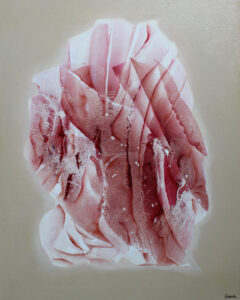
In my works the mixing of styles is not just an aesthetic choice. And the abstract and the figurative are not simply two pictorial techniques. But they intertwine in a visual dialogue that challenges perception, they are the means through which explore the complexity of the human experience, inviting us to look beyond what is visible and imagine what could be. The fusion of these two styles reflects my desire to explore the tension between reality and dream, where objects painted with almost photorealistic precision emerge from ethereal and dreamlike backgrounds. These objects, despite not existing in our tangible world, are depicted in such detail that they seem possible, almost palpable, thus challenging the boundaries between the possible and the imaginary. The pale and soft colors of the background contrast with the sharpness of the objects, underlining the duality between dream and reality. This aspect is emphsized by the use of gold or silver leaves in the background, which add an almost mystical dimension to the painting and envelop the subjects in reflections of soft light. Like that I would like to encourage people to reconnect with that part of themselves that remains curious, playful and full of wonder, just like when we were children, thus suggesting that in this return to the origins we could find the key to becoming better, more open adults, and less cynical.
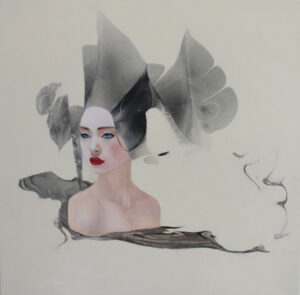
How important is mastering the technique in your work?
It’s crucial. I simply couldn’t create my works without mastering of the various painting techniques I use. In fact, without the appropriate technique, the idea would remain imprisoned into the mind. The right technique acts like a key that opens the doors of expression, allowing the work to exist and communicate with the world.
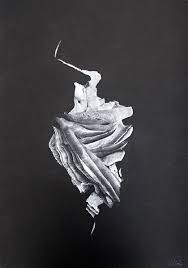
How and when do you understand that a work is finished and ready to be exhibited?
The end of a work of art is quite an elusive concept. For me there is no real a priori arrival point. Generally, when my dialogue with the work comes to an end, is when I recognize that what I wanted to communicate has been expressed and that the addition of further details would be a superfluous virtuosity compared to the evidence of the meaning, I decide to interrupt the process.
The subjects of your works seem to have an inspiration from Surrealism. Which artists inspire you and what fascinates you about this movement?
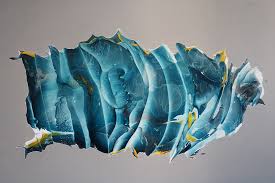
I really like Renè Magritte and Salvador Dalì. Magritte is known for his enigmatic and paradoxical images. Often his works present familiar objects in unexpected contexts, and this alienating and contradictory effect amuses me. I also appreciate and find interesting his concept of “seeing through”, which I am also working on, in different ways. Dalí with his limitless imagination explored the concept of double images, allowing us to see shapes or voids within other images, and this opened up new possibilities to read reality. In general I am referring to surrealism in relation to the objective of my artistic research and the creative modality. The objective is the exploration of the world of the unconscious and dreams through the use of free imagination. While the modality is a sort of psychic automatism with which I generally imagine my works.
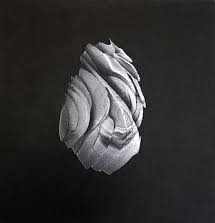
What are your future plans and what are you working on now?
In short, I will continue to explore the creation of a “bridge” between dream and reality. I am also working on a new project, on the idea of human beings as “containers”. But I don’t want to reveal anything in advance..